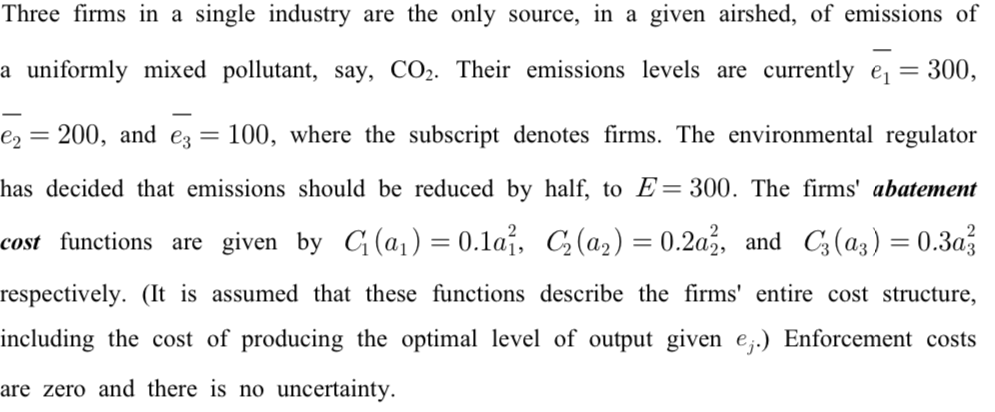hree firms in a single industry are the only source, in a given airshed, of emissions of uniformly mixed pollutant, say, CO₂. Their emissions levels are currently e₁ = 300, 2 = 200, and e3 = 100, where the subscript denotes firms. The environmental regulator as decided that emissions should be reduced by half, to E=300. The firms' abatement ost functions are given by C₁(a₁) = 0.1a, C₂(a₂) = 0.2a2, and C3 (a3) = 0.3a3 espectively. (It is assumed that these functions describe the firms' entire cost structure, ncluding the cost of producing the optimal level of output given e.) Enforcement costs re zero and there is no uncertainty.
hree firms in a single industry are the only source, in a given airshed, of emissions of uniformly mixed pollutant, say, CO₂. Their emissions levels are currently e₁ = 300, 2 = 200, and e3 = 100, where the subscript denotes firms. The environmental regulator as decided that emissions should be reduced by half, to E=300. The firms' abatement ost functions are given by C₁(a₁) = 0.1a, C₂(a₂) = 0.2a2, and C3 (a3) = 0.3a3 espectively. (It is assumed that these functions describe the firms' entire cost structure, ncluding the cost of producing the optimal level of output given e.) Enforcement costs re zero and there is no uncertainty.
Managerial Economics: Applications, Strategies and Tactics (MindTap Course List)
14th Edition
ISBN:9781305506381
Author:James R. McGuigan, R. Charles Moyer, Frederick H.deB. Harris
Publisher:James R. McGuigan, R. Charles Moyer, Frederick H.deB. Harris
Chapter3: Demand Analysis
Section: Chapter Questions
Problem 2.2CE
Related questions
Question
suppose the regulator imposes a Pigouvian tax on each unit of emissions. Calculate each firm's emissions level and the total tax collected.

Transcribed Image Text:Three firms in a single industry are the only source, in a given airshed, of emissions of
a uniformly mixed pollutant, say, CO₂. Their emissions levels are currently e₁ = 300,
e₂: = 200, and e3 = 100, where the subscript denotes firms. The environmental regulator
has decided that emissions should be reduced by half, to E=300. The firms' abatement
cost functions are given by C₁ (a₁) = 0.1a1, C₂(a₂) = 0.2a2, and C3 (a3) = 0.3a3
respectively. (It is assumed that these functions describe the firms' entire cost structure,
including the cost of producing the optimal level of output given e.) Enforcement costs
are zero and there is no uncertainty.
Expert Solution
This question has been solved!
Explore an expertly crafted, step-by-step solution for a thorough understanding of key concepts.
Step by step
Solved in 4 steps

Follow-up Questions
Read through expert solutions to related follow-up questions below.
Follow-up Question
a1 = (E1/0.1) = (150/0.1) = 45.8. is not make sense. How come?
Solution
Knowledge Booster
Learn more about
Need a deep-dive on the concept behind this application? Look no further. Learn more about this topic, economics and related others by exploring similar questions and additional content below.Recommended textbooks for you

Managerial Economics: Applications, Strategies an…
Economics
ISBN:
9781305506381
Author:
James R. McGuigan, R. Charles Moyer, Frederick H.deB. Harris
Publisher:
Cengage Learning

Managerial Economics: Applications, Strategies an…
Economics
ISBN:
9781305506381
Author:
James R. McGuigan, R. Charles Moyer, Frederick H.deB. Harris
Publisher:
Cengage Learning